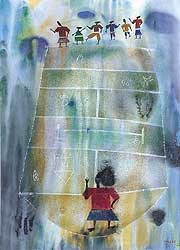 |
 |
 |
 |
The
Winners in the Oil Category
|
|
 |
|
|
| |
|
|
 |
Manwal
(Bahay Kubo Player Manual)
Oil on Canvass 48" x 48"
By
Robert Nelson V. Besana
Philippine Women's University - Fine Arts
About the game
BAHAY
KUBO (THE HUT)
Three
or more players can play Bahay Kubo, a game similar to tumbang
preso. Difference is the slippers are arranged like pyramid
and the it is the one who hits the pyramid
of slippers. Once the structure of slippers fall apart, the rest
of the players have to arrange it in an order so that the it
will not be able to hit other players, who will then be the next
it. Meanwhile, other players act as
decoys and runaway from the it to chase
them. This also gives the rest of the players time to re-arrange
the slippers since the it has to hit
the pyramid of slippers first before he begins hitting other players
(to get another it).
|
|
|
 |
|
|
 |
|
|
 |
|
|
| |
Ober-Ober
Oil on canvass 36" x 48"
By Orley Y. Ypon
Casa Gorordo Museum
About
the game
OBER-OBER (STRIKE THE SLIPPERS GAME)
Mostly
played by boys, this is a game of slippers. An outdoor game, it
needs a wide space as playing area which can be a wide street
or the front lawn.
Two
parallel lines are drawn wherein the other half of one's slipper
is on the opposing line while the other, which will serve as pamato,
is with the player at the starting line.
There
are two objects of the game. One is to strike your opponent's
slipper at the opposite line at your first try. After striking
it, you go to where you pamato-slipper went. The next objective
from there is to hit your other slipper until it gets to the starting
line, while other players try to strike you just the same. Once
your slipper passes the starting line, you win.
Sometimes
the game is reversed, meaning the starting line could be the other
way around. The naughty catch of this game is whoever losses will
get a spanking on his butt.
|
 |
|
|
|
 |
|
|
 |
|
|
 |
|
|
| |
Tatsing
Oil on Canvass 34.5" x 43"
By
Romeo Jose E. Rosete III
University of the Philippines Baguio
About
the game
TATSING (BOTTLE CAPS IN A SQUARE)
Usually
played by two or more boys, ages 9-12 or older. Each player should
have a good supply of bottle caps (tansan). Coins may be used
if bottle caps are not available. Also, a round, smooth pamato
or round stone (taw). A square is drawn on the ground, the size
of which is determined by the participants and the number of caps.
Each one contributes to the game.
Each
player puts as many bottle caps (coins) inside the square as possible
without leaving one's pamato inside.
-
The
first player puts one foot on the toe line, aims at the bottle
caps in the square, then throws his pamato at them.
-
He
gets all the caps that fly out of the square. (a) If his pamato
does not slide out of the square, he "dies" and looses his
turns. (b) If his pamato slides out of the square,
he continues to play. He puts his foot where his pamato
lands and hurls his stone once more at the bottle caps in
the square.
-
The
second player repeats movement no. 1. After he has knocked
out a cap or caps, he may if he wishes, hit the pamato
of the first player, thus, putting him out of the game temporarily.
He plays until he "dies."
-
The
first player goes back and hurls his pamato again,
repeating movement no. 1.
-
The
game ends when all the bottle caps are exhausted. The player
who gets the most number of caps is the winner.
|
 |
|
|
|
 |
|
|
 |
|
|
 |
|
|
 |
The
Winners in the Watercolor Category
|
|
 |
|
|
| |
|
|
 |
Karera
ng Tsinelas
Watercolor on paper 22" x 46"
By
Romeo R. Forbes Jr.
University of the East Caloocan - Fine Arts
About
the game
KARERA NG BANKANG TSINELAS (SLIPPER BOAT RACE)
Because
the Philippines is an archipelago, inland rivers and lakes are
common sights on our islands. It stands to reason that the slipper
boat race is a common activity in many towns and even the metropolis.
Each player must have his own slipper boat. The players race them
either in the river bank or water in the sidewalks if you live
in the metropolis. They race to a point of the bank agreed by
the players themselves. Players alternate who get to be judge
at the end of the finish line. Usually the player who has been
winning is chosen among others to judge. The game is popular most
especially during summer when the children are on vacation and
can spend their time in the river or in the streets to play. These
races are played with no holds barred. A player must therefore
watch out for his boat if the wind blows it sideways or is bogged
down by a stone or another boat.
|
|
|
 |
|
|
 |
|
|
 |
|
|
| |
|
Sa
Kanlungan ng Kamusmusan
Watercolor on paper 30" x 40"
By Ricky V. Ambaga
University of the Philippines Diliman - Fine Arts
About
the game
KADANG-KADANG (BAMBOO STILTS RACE)
Played
by two or more boys and girls, each player should have a pair of
kadang-kadang (bamboo stilts).
Two
parallel lines are drawn 10 meters (or more) apart. One is the starting
line and the other the finish line.
Players
on their stilts stand side by side on the starting line. At a given
signal, the two players walk their stilts towards the goal line.
Upon reaching the goal line, they turn around with stilts and return
to the starting line. The first player to reach the starting line
wins. This game can be played by teams without affecting its structural
pattern.
|
 |
|
|
|
 |
|
|
 |
|
|
 |
|
|
| |
Piko
Alay kay Mahal
Watercolor on Paper 22" x 29"
By
Yveese J. Belen
University of Santo Tomas - Fine Arts.
About
the game
PIKO (HOPSCOTCH)
Usually
played by two to eight girls, from 7-10 years old. Boys play this
when they are young, but hardy join when they get older.
Played
anytime of the day, the setting must be outdoors on any grassless
ground or any cemented area.
Each
player must have a pamato (either a flat stone, a piece
of broken china, a metal disk, even a cashew seed).
When
choosing who plays first (manuhan), all players line up
on a toe line, around 3 to 5 meters away from a chosen line. Each
one take turns in throwing her pamato towards the line.
Whoever succeeds in throwing her stone nearest is mano
(first to play), the second nearest is segunda mano, the
third, tercera mano, etc. with the last player called kulitad.
Now
the rules:
-
A
player must throw her pamato inside the target compartment every
time. The stone must not land on top of any line.
-
She
must not step on any line.
-
She
must not rest while skipping.
-
She
must not change from one foot to another while skipping. The
penalty for violating any of these rules is forfeiture of one's
turn to the next player.
Objective:
A player is supposed to hop back and forth on one foot through an
entire maze of squares, one hop to each square, two feet into double
boxes, straddling the middle line.
|
 |


|
|
|
 |
|
|
 |
|
|
 |
|
|
| |
|
|

